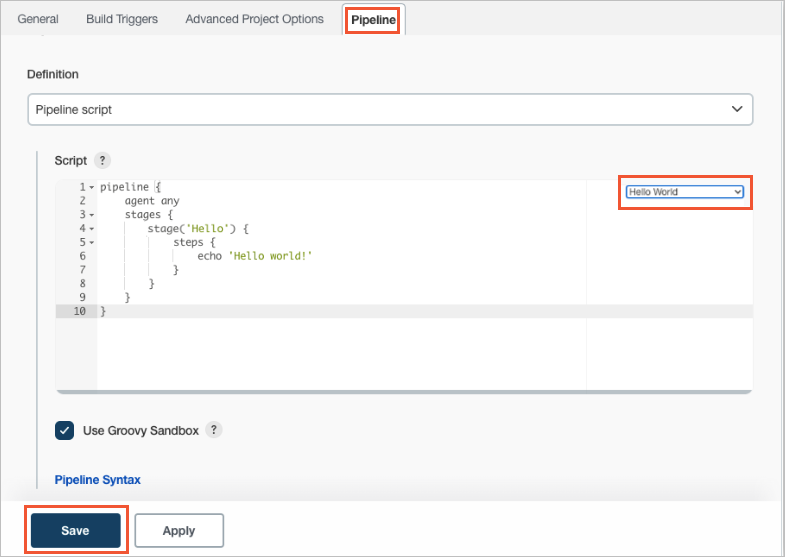This topic describes how to deploy Jenkins in an ACK Serverless cluster, and then create and deploy a simple application.
Prerequisites
An ACK Serverless cluster is created. For more information, see Create an ACK Serverless cluster.
A kubectl client is connected to the ACK Serverless cluster. For more information, see Connect to an ACK cluster by using kubectl.
Precautions
No technical support is provided for Jenkins. The developers who use Jenkins need to maintain Jenkins.
Step 1: Deploy Jenkins
Run the following command to configure Jenkins Helm Repo:
helm repo add jenkins https://charts.jenkins.io helm repo updateExpected output:
Hang tight while we grab the latest from your chart repositories... ...Successfully got an update from the "jenkins" chart repository Update Complete. ⎈Happy Helming!⎈NoteThe preceding repository is a Helm chart repository deployed outside China. Therefore, the configuration may be time-consuming if you configure the repository from an ACK Serverless cluster deployed in the Chinese mainland.
Install Jenkins.
Run the following command to create a namespace named
cicd:kubectl create ns cicdCreate a NAS volume.
Create a NAS volume to store data in the Jenkins home directory. Otherwise, all Jenkins configurations are lost after the Jenkins master pod is restarted.
If you use the Container Storage Interface (CSI) plug-in, refer to Mount a statically provisioned NAS volume to create a NAS volume.
If you use the FlexVolume plug-in, refer to Mount a statically provisioned NAS volume to create a NAS volume.
Run the following command to deploy Jenkins in the
cicdnamespace:helm -n cicd install jenkins jenkins/jenkins \ --set persistence.existingClaim=pvc-nas \ --set controller.serviceType="LoadBalancer" \ --set controller.adminPassword="admin"persistence.existingClaim=pvc-nas: Set the value to the name of the persistent volume claim (PVC) that is used to mount the NAS volume. In this example, the PVC is named pvc-nas and belongs to the
cicdnamespace. This parameter is required.controller.serviceType="LoadBalancer": The default value is ClusterIP. This parameter is optional.
controller.adminPassword="admin": The default password is randomly generated. This parameter is optional. For more information about how to obtain the randomly generated default password, see Use a load balancer to access the Jenkins Service and obtain the randomly generated default password.
For more information about other parameters, see helm-charts.
Run the following command to query the status of the Jenkins pod and wait until the Jenkins pods runs as normal:
kubectl -n cicd get poExpected output:
NAME READY STATUS RESTARTS AGE jenkins-0 2/2 Running 0 3m3s
Use a web browser to access Jenkins and enter your username and password.
For more information, see Use a load balancer to access the Jenkins Service and obtain the randomly generated default password.
Step 2: Create a pipeline build
This section uses the first-pipeline pipeline build as an example to demonstrate how to create a pipeline build. When you create a pipeline build, Jenkins dynamically launches a slave pod in the ACK Serverless cluster and runs the build by default. After Jenkins finishes running the build, it immediately releases the slave pod. For more information about Jenkins configurations, see Jenkins.
Log on to Jenkins and click New Item in the left-side navigation pane.
In the Enter an item name section, enter first-pipeline, select Pipeline, and then click OK.
On the top of the page, click the Pipeline tab, select the Hello World template, and then click Save.

In the left-side navigation pane of the page, click Build Now to run the build.
In the left-side navigation pane of the page, click Build History and then click 1# to go to the details page of the pipeline. The, click Console Output to view the build results.
Use a load balancer to access the Jenkins Service and obtain the randomly generated default password
The default type of the Jenkins Service is ClusterIP. If you want to use a load balancer to expose the Jenkins Service, run the following command:
kubectl -n cicd patch svc jenkins -p '{"spec": {"type": "LoadBalancer"}}'If you do not specify a password when you deploy Jenkins, run the following command to obtain the default password, which is randomly generated by Jenkins:
kubectl -n cicd exec -it svc/jenkins -c jenkins -- /bin/cat /run/secrets/additional/chart-admin-password && echo